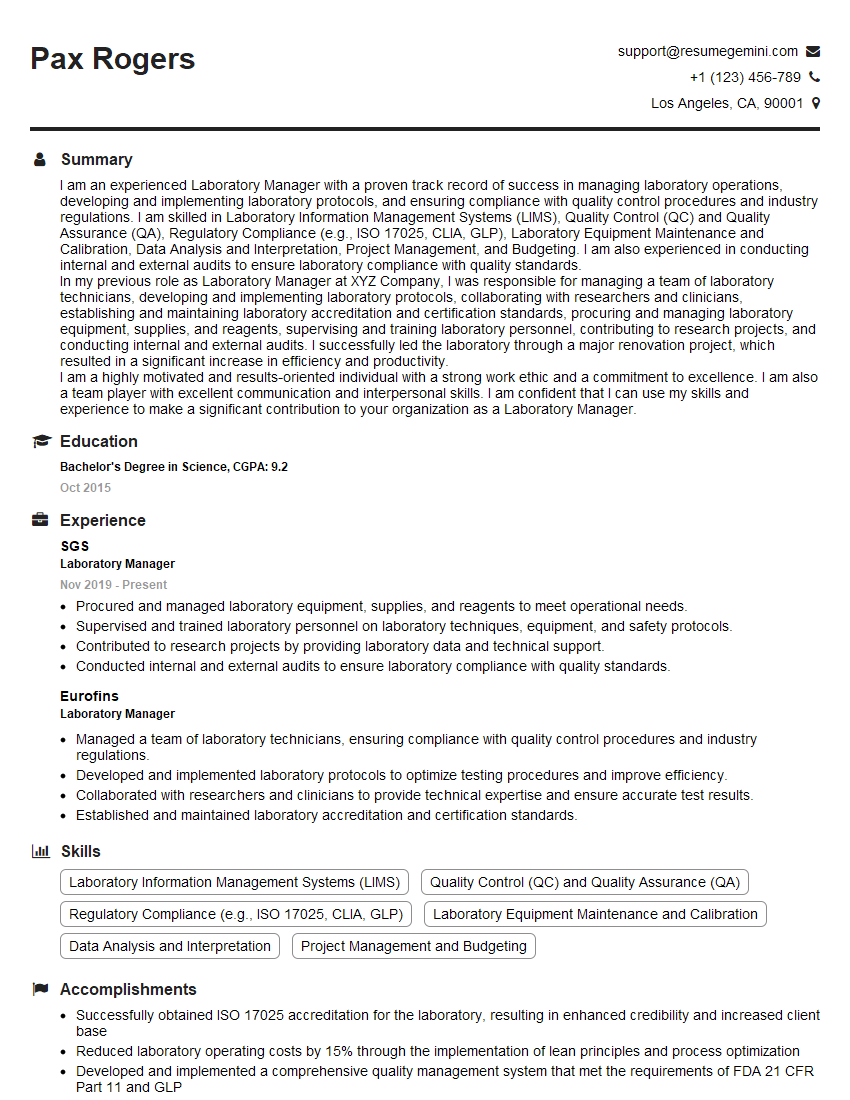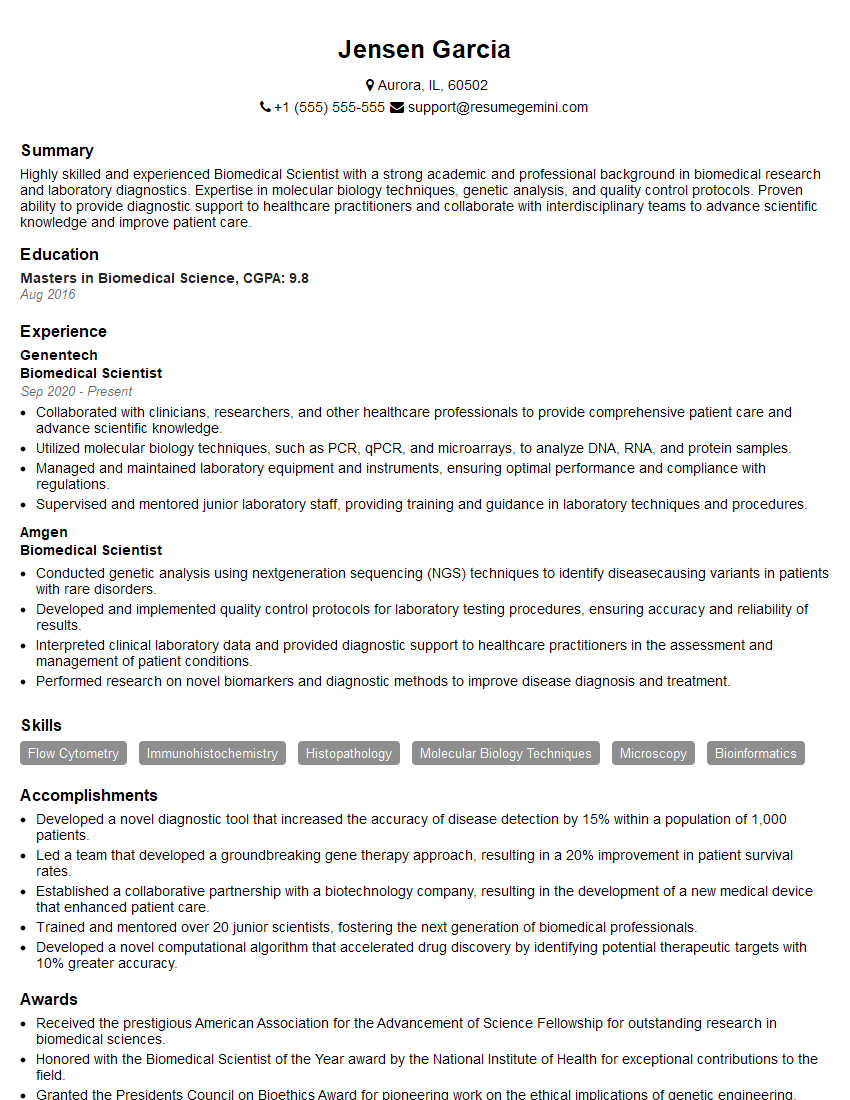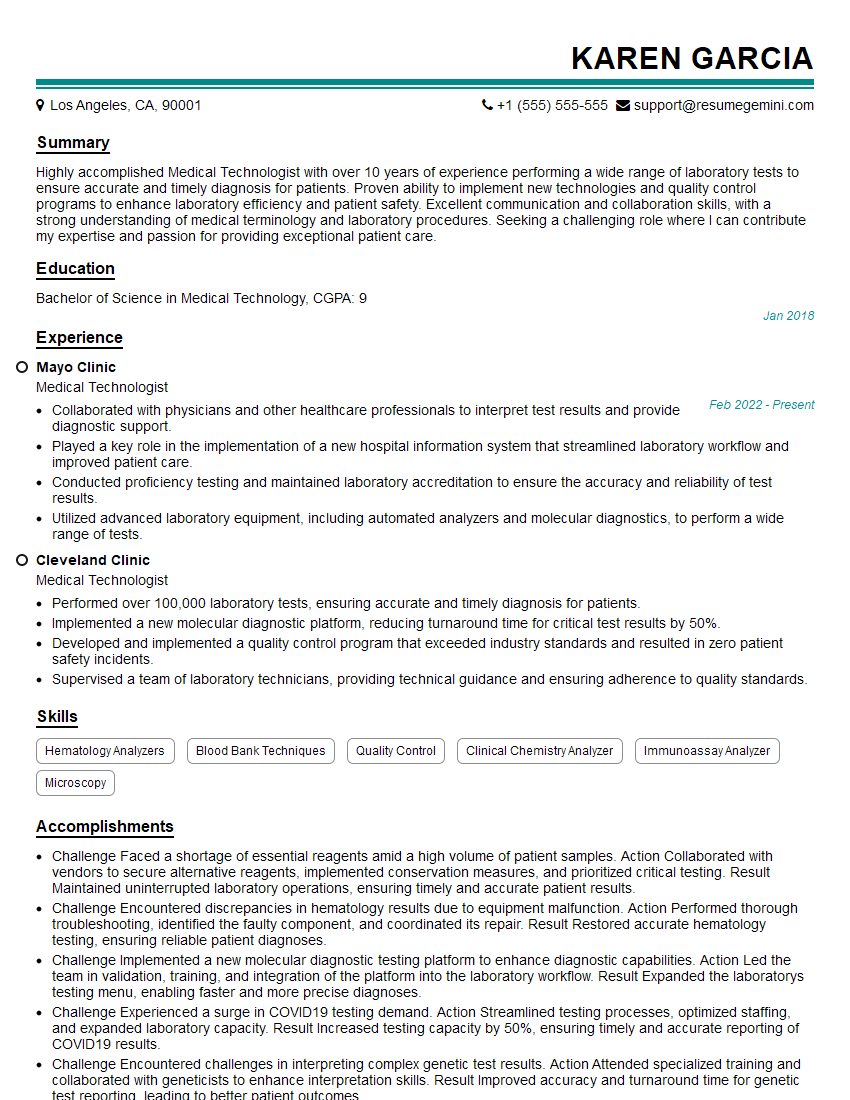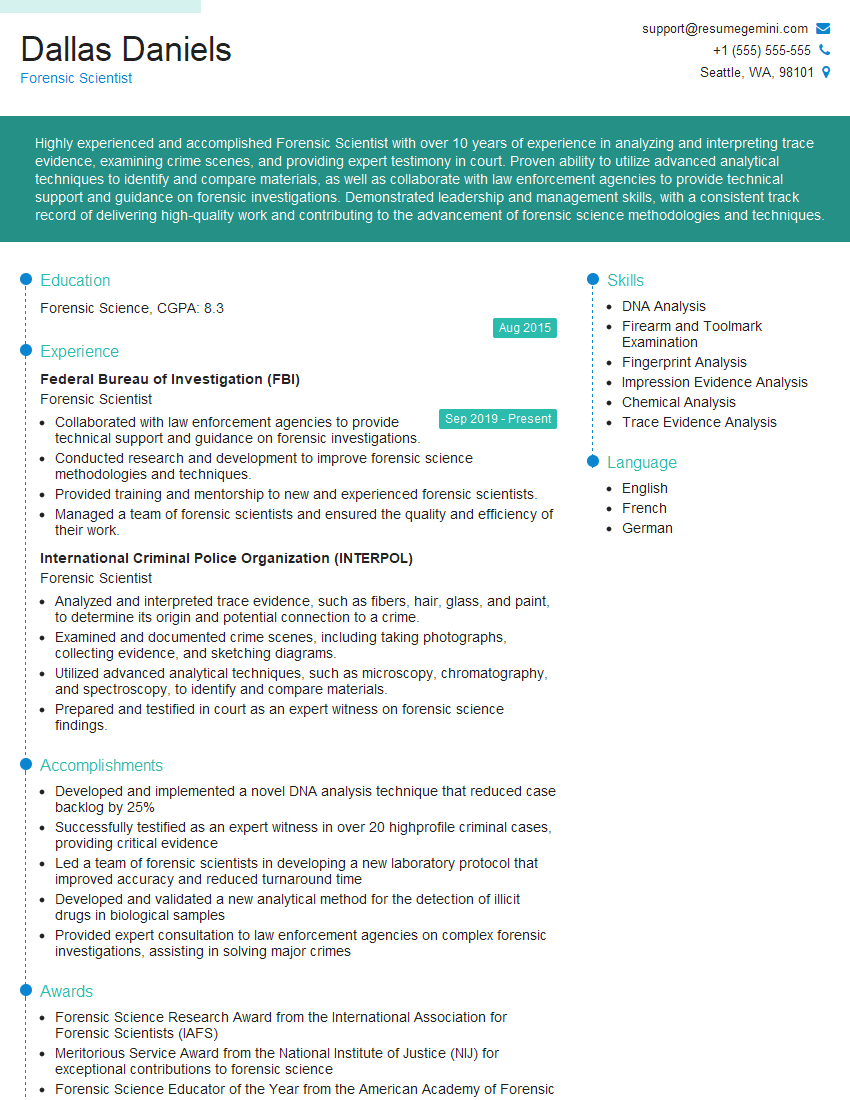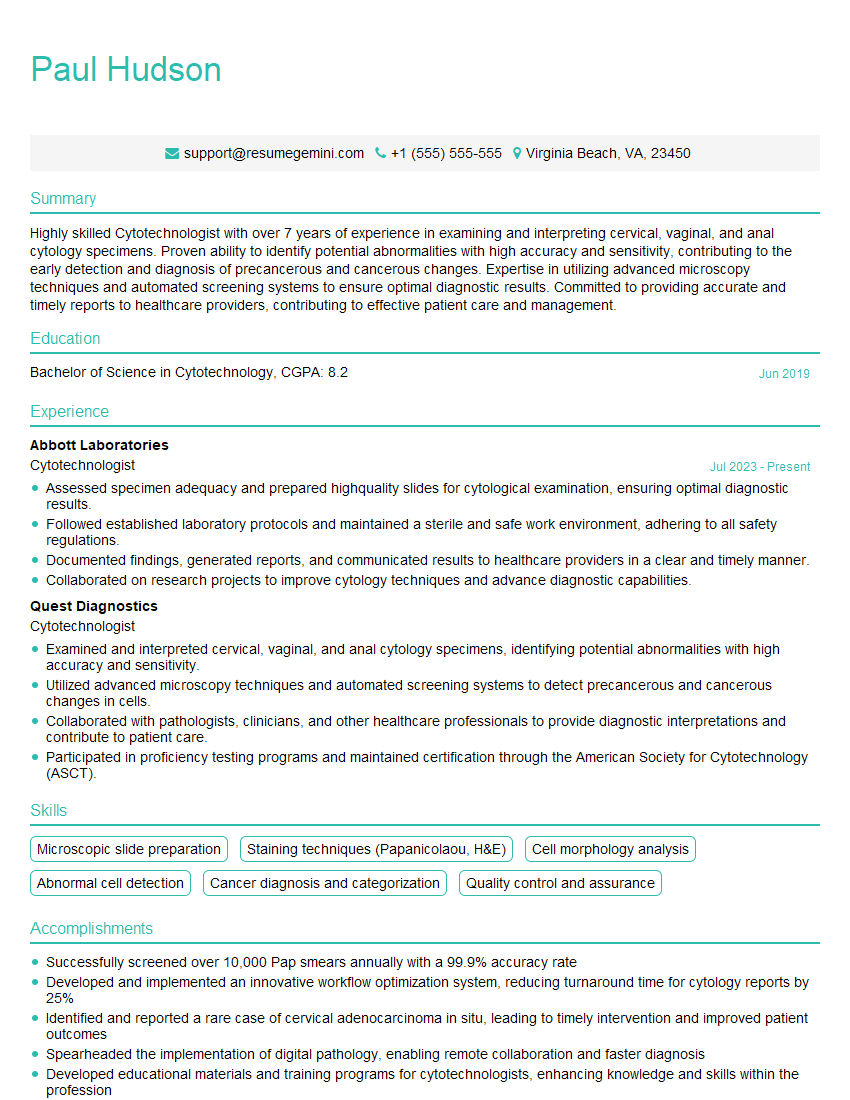Interviews are opportunities to demonstrate your expertise, and this guide is here to help you shine. Explore the essential Cell Staining interview questions that employers frequently ask, paired with strategies for crafting responses that set you apart from the competition.
Questions Asked in Cell Staining Interview
Q 1. Explain the principle of fluorescence microscopy in cell staining.
Fluorescence microscopy is a powerful technique used to visualize cellular structures and processes by exploiting the property of fluorescence. It works by illuminating a sample with a specific wavelength of light (excitation light), causing fluorescent molecules (fluorophores) within the sample to absorb this light and emit light at a longer wavelength (emission light). This emitted light is then detected by the microscope, creating an image of the fluorescently labeled structures. Think of it like shining a blacklight on a poster – only the parts that are fluorescent will glow.
The key is the fluorophore’s selective binding to a cellular component of interest. For example, a fluorescent antibody might be used to bind to a specific protein within a cell. The microscope’s filters are carefully selected to isolate the emitted light from the excitation light, enabling clear visualization of the targeted structures against a dark background.
Q 2. Describe the steps involved in performing immunofluorescence staining.
Immunofluorescence staining is a widely used technique to locate specific proteins or antigens within cells or tissues using fluorescently labeled antibodies. Here are the steps involved:
- Sample Preparation: This includes cell culture, harvesting, and fixation (using methods like paraformaldehyde or methanol to preserve cell structure) and permeabilization (using detergents like Triton X-100 to allow antibody penetration).
- Blocking: This step minimizes non-specific antibody binding by blocking non-antigenic sites with a blocking solution (e.g., BSA or serum).
- Primary Antibody Incubation: The sample is incubated with a primary antibody, which is specifically designed to bind to the target protein. This incubation usually happens overnight at 4°C for optimal binding.
- Washing: This step is crucial to remove unbound primary antibody, preventing background noise in your imaging.
- Secondary Antibody Incubation: The sample is then incubated with a fluorescently labeled secondary antibody that specifically binds to the primary antibody. The secondary antibody carries the fluorophore, making the target protein visible under a fluorescence microscope.
- Washing: Another round of washing removes unbound secondary antibody.
- Mounting: The sample is mounted with a mounting medium (containing antifade reagent to prevent photobleaching) and a coverslip.
- Microscopy: The sample is visualized using a fluorescence microscope.
For instance, one might use immunofluorescence to locate the distribution of a specific cytoskeletal protein in a cell, like actin, using fluorescently labeled phalloidin.
Q 3. What are the different types of cell stains and their applications?
Numerous cell stains exist, each with specific applications:
- Hematoxylin and Eosin (H&E): This is a routine stain in histology, providing excellent contrast between cellular nuclei (stained purple by hematoxylin) and cytoplasm (stained pink by eosin). It’s invaluable for basic tissue morphology analysis.
- DAPI (4′,6-diamidino-2-phenylindole): A fluorescent DNA stain that binds strongly to adenine-thymine rich regions of DNA. Used for visualizing nuclei and determining cell density.
- Phalloidin: Binds to F-actin filaments, a major component of the cytoskeleton. Often conjugated to fluorescent dyes for visualizing actin structures like stress fibers and filopodia.
- Gram Stain: This differential stain distinguishes between Gram-positive and Gram-negative bacteria based on cell wall composition. Gram-positive bacteria appear purple, and Gram-negative bacteria appear pink.
- Oil Red O: A fat-soluble dye that stains neutral lipids, commonly used to assess lipid accumulation in cells.
- Periodic acid-Schiff (PAS) stain: Detects polysaccharides and glycoproteins, making it useful for visualizing basement membranes and mucus secretions.
The choice of stain depends entirely on the research question. For example, if you want to study changes in lipid droplet accumulation in response to a certain treatment, Oil Red O would be your stain of choice.
Q 4. How would you troubleshoot problems with non-specific staining?
Non-specific staining, also known as background staining, can seriously hinder data interpretation. Here’s how to troubleshoot it:
- Increase Blocking: Use a higher concentration of blocking agent, extend the blocking incubation time, or try a different blocking agent altogether (e.g., switch from BSA to serum).
- Optimize Antibody Concentration: Too high a concentration can lead to non-specific binding. Perform a titration experiment to determine the optimal antibody concentration.
- Improve Washing Steps: Insufficient washing allows unbound antibodies to remain, increasing background. Increase the number of washes or the wash duration.
- Check Antibody Specificity: Ensure that the primary antibody is highly specific to the target antigen. Consider using positive and negative controls (discussed in the next question) to validate specificity.
- Reduce Permeabilization: If your cells are overly permeabilized, antibodies may bind non-specifically. Try a milder detergent or reduce the permeabilization time.
- Use Pre-adsorbed Antibodies: If you suspect the antibody might be binding to other antigens in your sample, consider pre-adsorbing it with the potential cross-reacting antigens.
Systematic troubleshooting, starting with the simplest steps and moving to more complex ones, is key to success.
Q 5. Explain the concept of positive and negative controls in cell staining.
Positive and negative controls are essential to validate the results of cell staining experiments:
- Positive Control: A sample that is known to express the target protein. It ensures the staining procedure is working correctly and that the antibodies are functional. A positive control should exhibit strong specific staining.
- Negative Control: A sample that lacks the target protein. It helps determine the level of background or non-specific staining. Ideally, a negative control should show minimal to no staining.
Imagine staining for a specific protein in cancer cells. A positive control might be a cell line known to overexpress this protein, while a negative control could be a healthy cell line that lacks the protein. The positive control confirms the experiment is functional, the negative control confirms the specificity.
Q 6. What are the safety precautions you would take when handling staining reagents?
Safety is paramount when handling staining reagents. Many are toxic or hazardous:
- Personal Protective Equipment (PPE): Always wear appropriate PPE, including lab coats, gloves (nitrile gloves are recommended), eye protection (goggles), and potentially a respirator, depending on the reagents.
- Proper Waste Disposal: Dispose of staining reagents and used solutions according to your institution’s guidelines. Many staining solutions are hazardous waste and require special handling.
- Work in a Fume Hood: When working with volatile or toxic reagents, perform the staining procedures within a fume hood to prevent inhalation.
- Avoid Skin Contact: Be extremely careful to avoid skin contact. Immediately wash any spills or splashes with copious amounts of water.
- Handle with Care: Avoid generating aerosols and work slowly and carefully to minimize the risk of accidents.
- Consult Safety Data Sheets (SDS): Always refer to the SDS for each reagent to understand its hazards and appropriate handling procedures.
Remember, careful adherence to safety procedures protects both you and the environment.
Q 7. Compare and contrast different fixation methods for cell staining.
Several fixation methods are used for cell staining, each with advantages and disadvantages:
- Paraformaldehyde (PFA): A cross-linking fixative that preserves morphology well. It’s commonly used for immunofluorescence and other techniques where maintaining the structural integrity of the cells is critical. However, it can sometimes mask epitopes (antigenic sites) which is a potential drawback for immunostaining.
- Methanol: A denaturing fixative that precipitates proteins. It’s quick and effective, but it can alter cell morphology more than PFA. It’s often used for immunocytochemistry but not ideal if delicate structures need to be preserved.
- Acetone: Similar to methanol, it’s a denaturing fixative, quick, and used for immunocytochemistry and other procedures, but again can affect morphology.
- Glutaraldehyde: A very strong cross-linking fixative, offering excellent preservation of ultrastructure. It’s commonly used for electron microscopy but is less suitable for immunofluorescence due to potential epitope masking.
The choice of fixative depends on the application. If preserving fine cell morphology is paramount, PFA is a good choice; if speed is more important, and fine details aren’t crucial, methanol or acetone might suffice. For electron microscopy, where maximum preservation is required, glutaraldehyde is the preferred choice.
Q 8. Describe the process of preparing tissue samples for histological staining.
Preparing tissue samples for histological staining is a crucial first step that significantly impacts the quality and reliability of the results. It’s a multi-step process involving fixation, processing, embedding, sectioning, and finally, staining.
Fixation: This step preserves the tissue structure and prevents degradation. Common fixatives include formalin (formaldehyde solution), which crosslinks proteins, making the tissue rigid and preventing enzymatic degradation. The choice of fixative depends on the specific target and the type of staining planned. For example, some fixatives are better for immunohistochemistry than others.
Processing: This involves dehydrating the tissue by passing it through a series of graded alcohols (e.g., 70%, 95%, 100% ethanol), followed by clearing with a solvent like xylene that is miscible with both alcohol and paraffin. This prepares the tissue for embedding.
Embedding: The dehydrated tissue is infiltrated with paraffin wax, which provides structural support during sectioning. The paraffin-embedded tissue is then cooled and solidified into a block.
Sectioning: Thin slices (typically 3-5 µm thick) of the tissue are cut using a microtome. These sections are then mounted on glass slides.
Staining: After mounting, the sections are ready for staining, which involves applying dyes to visualize specific cellular components.
Imagine preparing a delicate flower for display – fixation is like carefully preserving its shape, processing is like gently drying it, and embedding is like mounting it for safekeeping. Each step is crucial for achieving a beautiful and informative final result.
Q 9. What are the advantages and disadvantages of using hematoxylin and eosin staining?
Hematoxylin and eosin (H&E) staining is the gold standard for routine histological examination. It’s a simple, inexpensive, and widely used method for visualizing tissue architecture.
Advantages: H&E staining provides excellent contrast between different tissue components. Hematoxylin, a basic dye, stains nuclei blue/purple, while eosin, an acidic dye, stains cytoplasm and extracellular matrix pink/red. This allows for easy identification of cell types and tissue structures.
Disadvantages: H&E staining lacks specificity. While excellent for general tissue morphology, it doesn’t highlight specific proteins or other cellular components. It can also overstain or understain depending on factors like fixation and tissue type, leading to suboptimal results. For more specific information, immunohistochemistry or other specialized stains are needed.
Think of H&E as a broad-stroke painting of a landscape – it provides an overview, but doesn’t capture the fine details. If you need those fine details, more specialized staining techniques are required.
Q 10. Explain how you would optimize the concentration of a primary antibody for immunostaining.
Optimizing the primary antibody concentration for immunostaining is crucial for achieving specific and strong staining without background noise. This is typically done through a titration experiment.
Prepare dilutions: Start with a high concentration of your primary antibody and make serial dilutions (e.g., 1:50, 1:100, 1:200, 1:500, 1:1000). Use a suitable blocking buffer to prevent non-specific binding.
Perform staining: Apply each dilution to separate tissue sections. Follow your standard immunostaining protocol.
Analyze results: Examine the stained sections under a microscope. Look for the optimal dilution that produces strong specific staining while minimizing background staining. A too high concentration can lead to high background, while a too low concentration can lead to weak or no staining.
Document findings: Record the antibody concentration, dilution factor and your observations (intensity, specificity, background) for each dilution.
This process is similar to finding the ‘sweet spot’ in a recipe – too much of an ingredient can ruin the dish, too little and it’s bland. The ideal concentration provides the best balance between signal and noise.
Q 11. How do you determine the appropriate counterstain for a particular cell staining protocol?
Choosing the appropriate counterstain depends heavily on the primary stain and the information you want to emphasize in your analysis. A counterstain enhances contrast and highlights other cellular components, providing crucial contextual information.
If using a nuclear stain (e.g., DAPI): A counterstain that highlights cytoplasmic structures (e.g., eosin, fast red) would be appropriate to contrast the stained nucleus with the surrounding cytoplasm.
If using a cytoplasmic stain: A nuclear counterstain (e.g., hematoxylin, methyl green) is often used to delineate cell boundaries and provide a structural framework.
Consider the color: Select a counterstain that offers a contrasting color to your primary stain, so the combined image is clear and interpretable. For example, a red primary stain might look good paired with a green counterstain.
The counterstain acts like a supporting actor in a play – it doesn’t steal the spotlight, but it adds depth and context to the main character (your primary staining). Careful selection enhances the overall presentation.
Q 12. Describe the different types of microscopy used in cell staining.
Various microscopy techniques are used to visualize stained cells, each offering unique advantages.
Brightfield microscopy: This is the most common technique, using transmitted light to visualize stained samples. It’s suitable for most histological stains, including H&E.
Fluorescence microscopy: This technique uses fluorescent dyes or antibodies conjugated to fluorophores to visualize specific structures. It’s crucial for immunofluorescence studies and allows for multiplexing (simultaneously visualizing different targets).
Confocal microscopy: A type of fluorescence microscopy that uses laser scanning to create high-resolution images with reduced background noise. This is particularly useful for examining thick tissues or 3D structures.
Electron microscopy (TEM and SEM): These techniques offer very high resolution, allowing visualization of cellular ultrastructure. They are not typically used with conventional stains but with heavy metal stains for electron dense contrast.
Choosing the right microscopy technique depends on the research question and the level of detail required. Each technique adds a different layer of magnification and detail to cell analysis.
Q 13. Explain the concept of antigen retrieval in immunohistochemistry.
Antigen retrieval is a crucial step in immunohistochemistry (IHC) that enhances antibody binding to target antigens. During tissue processing (fixation, embedding, sectioning), formaldehyde crosslinking and other procedures can mask epitopes (antigen sites), making them inaccessible to antibodies. Antigen retrieval techniques reverse this process, increasing antibody accessibility and improving the staining signal.
Heat-induced epitope retrieval (HIER): This involves heating the tissue sections in a buffer (e.g., citrate buffer, EDTA buffer) at a specific pH. Heat breaks the formaldehyde crosslinks and unmasks the epitopes. This method is commonly used and relatively simple.
Enzyme-induced epitope retrieval (EIER): This method uses proteolytic enzymes (e.g., trypsin, proteinase K) to digest proteins and expose masked epitopes. It’s a more gentle approach than HIER and sometimes preferred for certain antigens.
Think of it as removing a protective coating from a toy to allow for play – antigen retrieval exposes the target antigen for antibody binding, making the antibody more efficient.
Q 14. How do you quantify the results of cell staining experiments?
Quantifying cell staining results often depends on the specific experiment and research question. Several methods exist, each with strengths and limitations.
Microscopic quantification: This involves manually counting stained cells or measuring the intensity of staining in specific areas of interest. Image analysis software can help automate this process and provide quantitative data, such as the percentage of positive cells or the mean fluorescence intensity.
Flow cytometry: This technique can quantify the number of cells expressing a specific marker. Cells are stained with fluorescent antibodies, and a flow cytometer measures the fluorescence intensity of individual cells. This allows for high-throughput analysis.
Image analysis software: Many software packages (e.g., ImageJ, CellProfiler) allow for automated analysis of stained images. These programs can segment images, identify cells, and quantify staining intensity, colocalization of different markers, and other relevant parameters.
The best method depends heavily on the experimental design and research aims. Careful planning and selection of appropriate quantitative approaches are crucial for drawing meaningful conclusions.
Q 15. What are the common artifacts encountered in cell staining and how can they be avoided?
Artifacts in cell staining are essentially any unwanted features or structures that appear in the stained sample, obscuring the true biological details. They can significantly impact the accuracy of your results and lead to misinterpretations. Common artifacts include precipitation of the stain, uneven staining, background noise, and damage to the cells themselves.
- Precipitation of the stain: This often manifests as granular deposits on the slide, which can be mistaken for cellular structures. It’s usually caused by using an overly concentrated stain, improper mixing, or allowing the stain to dry too quickly. Avoiding it involves careful dilution of reagents, gentle mixing, and maintaining optimal humidity.
- Uneven staining: This can be due to inconsistencies in the staining process or the inherent characteristics of the tissue sample. For example, variations in tissue thickness can result in uneven dye penetration. To mitigate this, ensure consistent sample preparation, including uniform sectioning for tissue samples, and optimize incubation times and staining protocols.
- Background noise: This refers to unwanted staining of the background of the slide, making it difficult to distinguish the cells of interest. It can be caused by non-specific binding of the stain. Proper blocking steps, using appropriate controls (e.g., negative controls), and optimizing washing procedures are essential to reduce background noise.
- Cell damage: Harsh treatment during sample preparation can damage cells, leading to artifacts like cell shrinkage or membrane disruption. Gentle handling of samples, using appropriate fixatives, and optimized staining protocols are crucial.
In my experience, meticulous attention to detail during every step of the staining process is key to minimizing artifacts. For instance, I once encountered significant background noise in an immunofluorescence experiment due to insufficient blocking. By adding an extra blocking step with a higher concentration of blocking solution, the problem was completely resolved.
Career Expert Tips:
- Ace those interviews! Prepare effectively by reviewing the Top 50 Most Common Interview Questions on ResumeGemini.
- Navigate your job search with confidence! Explore a wide range of Career Tips on ResumeGemini. Learn about common challenges and recommendations to overcome them.
- Craft the perfect resume! Master the Art of Resume Writing with ResumeGemini’s guide. Showcase your unique qualifications and achievements effectively.
- Don’t miss out on holiday savings! Build your dream resume with ResumeGemini’s ATS optimized templates.
Q 16. Discuss your experience with different types of fluorescent dyes.
My experience encompasses a wide range of fluorescent dyes, each with its unique characteristics and applications. I’ve extensively used dyes from various families, including:
- DAPI (4′,6-diamidino-2-phenylindole): A commonly used nuclear stain that binds to DNA and emits blue fluorescence. It’s an excellent tool for visualizing nuclei and determining cell density.
- Fluorescein isothiocyanate (FITC): A widely employed dye that emits green fluorescence. It’s frequently used in immunofluorescence applications to label antibodies, allowing visualization of specific proteins.
- Phycoerythrin (PE): A red fluorescent protein derived from algae. It’s often used in flow cytometry and immunofluorescence for multicolor labeling experiments, offering distinct spectral properties from FITC and other dyes.
- Alexa Fluor dyes: A family of highly sensitive and photostable fluorescent dyes available in a wide range of excitation/emission wavelengths, enabling multiplexing in imaging applications. I particularly value their brightness and resistance to photobleaching.
Choosing the appropriate dye is critical and depends on the specific experimental design. Considerations include the target molecule, the desired spectral properties for multiplexing (if applicable), and the compatibility with other dyes and detection methods.
Q 17. How do you ensure the quality control of your cell staining results?
Quality control is paramount in cell staining. My approach involves a multi-layered strategy:
- Positive and negative controls: Including both positive and negative controls is essential to validate the specificity of the staining and assess background noise. A positive control shows expected staining, while a negative control lacks the target molecule or antibody, helping to identify non-specific binding.
- Microscopic evaluation: Thorough microscopic examination of stained slides is crucial to assess staining quality, including evenness of staining, background noise, and presence of artifacts. This often includes visual inspection at different magnifications and through different filter sets (if using fluorescence).
- Image analysis: Quantitative image analysis software allows for objective assessment of staining intensity, cell count, and other relevant parameters. This removes subjective bias and allows for statistically rigorous comparison between experimental groups.
- Reagent quality: Using high-quality reagents, stored and handled according to manufacturer instructions, is crucial to consistent staining quality. This includes appropriate dilutions and avoiding contamination.
- Documentation: Detailed record-keeping is essential, including the batch number of reagents, staining protocols, and imaging settings. This allows for reproducibility and troubleshooting if issues arise.
For instance, if I notice inconsistencies in staining intensity across different samples, I review each step of the protocol, examining reagents, incubation times, and washing steps. If the problem persists, I may repeat the experiment using a new batch of reagents or modifying the protocol to address potential sources of error.
Q 18. Describe your experience working with different types of tissue samples.
My experience includes working with diverse tissue samples, including:
- Formalin-fixed paraffin-embedded (FFPE) tissue: This is a common tissue preservation method requiring deparaffinization and antigen retrieval steps before staining. The challenges include potential antigen masking during the fixation process. Specialized techniques like antigen retrieval are essential to ensure antibody binding.
- Frozen tissue sections: These retain better antigenicity but are more susceptible to ice crystal formation. Rapid freezing is crucial to minimize artifact formation.
- Cell cultures (adherent and suspension): Cell cultures offer homogeneity and ease of manipulation. However, challenges may arise from detachment, cell clumping, and variability in cell morphology.
- Whole mount preparations: These allow for visualization of the entire tissue or organism, but require specialized clearing and staining techniques. Penetration of the stain is a key challenge.
Each tissue type requires an optimized protocol based on its specific properties and the intended staining technique. For example, I might use different antigen retrieval methods for FFPE tissues depending on the target epitope.
Q 19. What software or image analysis tools are you familiar with for cell staining?
I’m proficient in several software packages for image analysis related to cell staining. My experience includes:
- ImageJ/Fiji: This open-source software offers a wide range of tools for image processing, analysis, and measurement, including tools for quantification of fluorescence intensity, cell counting, and colocalization analysis.
- CellProfiler: This is a powerful image analysis software specifically designed for high-throughput screening. I’ve used it for automated image analysis of large datasets, which would be incredibly time-consuming to do manually.
- Imaris: This software excels in 3D image analysis and visualization. Its capability for 3D rendering and object tracking makes it ideal for complex imaging experiments.
- NIS Elements (Nikon): This is a microscopy software package integrated with Nikon microscopes that is useful for acquiring and analyzing images from experiments.
The choice of software depends on the complexity of the experiment and the specific analyses required. For simple quantification of fluorescence intensity, ImageJ might suffice; however, for complex 3D imaging and analysis, Imaris is often more suitable.
Q 20. Explain your experience with flow cytometry techniques.
Flow cytometry is a powerful technique for analyzing single cells based on their light scattering and fluorescence properties. I’ve extensive experience in its application, from sample preparation to data analysis. My experience covers:
- Sample preparation: This includes single-cell suspensions, antibody labeling, and appropriate controls. Ensuring a single-cell suspension is crucial for accurate analysis. Clumping can lead to inaccurate measurements.
- Instrument operation: I am proficient in operating various flow cytometers, optimizing instrument settings, and troubleshooting issues like clogging and signal drift.
- Data acquisition and analysis: I’m skilled in acquiring high-quality data, using compensation techniques to correct for spectral overlap between fluorophores, and performing advanced data analysis using FlowJo and other flow cytometry software. Gating strategies are carefully chosen to accurately identify cell populations.
- Experimental design: My experience also encompasses designing appropriate experiments using flow cytometry to address specific biological questions. This includes carefully considering the choice of antibodies, fluorochromes, and controls.
For instance, I once used flow cytometry to identify and quantify specific immune cell populations in a mouse model of inflammation. The careful gating strategy was essential for separating and accurately counting the distinct cell populations of interest.
Q 21. How do you interpret and report the results of cell staining experiments?
Interpreting and reporting cell staining results requires a systematic approach. My process involves:
- Qualitative assessment: This involves visual inspection of stained samples using microscopy to observe cell morphology, localization of stained structures, and presence of artifacts. Key features are documented using images and descriptions.
- Quantitative analysis: Image analysis software or flow cytometry data analysis is used to quantify parameters such as fluorescence intensity, cell count, colocalization, and other relevant metrics. Statistical analysis is performed to determine significance.
- Data visualization: Results are presented using clear and concise graphs, charts, and images. This allows for easy understanding of the data and interpretation of the findings.
- Report writing: A comprehensive report includes the experimental design, methods, results, discussion of findings, and conclusions. It should clearly communicate the experimental strategy, the observed results, their significance, and potential limitations.
It’s crucial to critically evaluate the results and consider potential sources of error or bias. For example, any limitations related to the specificity of antibodies or potential artifacts would be discussed in the context of the findings.
Q 22. What are the limitations of cell staining techniques?
Cell staining, while a powerful technique for visualizing cellular structures and processes, has several limitations. One major limitation is the potential for artifacts. The staining process itself can introduce distortions or changes to the cell’s morphology, leading to misinterpretations of the results. For example, harsh fixation methods might shrink or distort cells, making accurate measurements challenging.
Another limitation is the inherent specificity of many stains. While some stains target very specific cellular components (like DAPI for DNA), others may have less precise binding, leading to non-specific staining and background noise. This can obscure the signal from the target structures and hinder accurate analysis. Furthermore, the intensity of staining can be affected by factors like cell density, permeabilization efficiency, and the concentration of the staining solution, leading to variations in results even within the same sample. Finally, many staining techniques require specialized equipment and expertise, making them time-consuming and potentially expensive.
- Artifact Formation: Poor fixation or permeabilization can cause shrinkage or distortion of cellular structures.
- Non-specific Staining: Stains may bind non-specifically to other cellular components, obscuring the signal.
- Variability: Factors like cell density and reagent concentration influence staining intensity.
Q 23. Describe your experience with troubleshooting problems related to cell staining.
Troubleshooting cell staining issues is a significant part of my daily work. I’ve encountered a wide range of problems, from faint or uneven staining to complete lack of signal. My approach is systematic, starting with the simplest possibilities and moving to more complex ones. I first check the quality of my reagents – expired or improperly stored reagents are a common culprit. I then verify the integrity of the cells themselves. Were they handled correctly? Were they healthy before staining? Microscopic examination of unstained cells helps assess their health and viability. If the problem persists, I meticulously review the staining protocol itself: the incubation times, concentrations of reagents, and the order of steps. Even small deviations can dramatically impact results.
For example, if I encounter weak staining, I might increase the incubation time with the dye or its concentration. Conversely, if the background is too high, I’ll try washing the cells more thoroughly or using a different blocking agent. Documentation is crucial – I maintain detailed records of each step in the process, including reagent lots and incubation times, so that I can identify potential problems and prevent them from recurring.
Q 24. How would you handle a situation where your staining results are inconsistent?
Inconsistent staining results are a serious concern. To address this, my first step is to identify the source of the inconsistency. I begin by carefully reviewing all aspects of the experimental procedure, comparing consistent and inconsistent results. Are there differences in cell preparation, fixation, permeabilization, or staining procedures? I check the quality of reagents, paying close attention to expiration dates and storage conditions. I ensure that all reagents are freshly prepared or from reputable sources. I also assess the variability in cell density across the samples to exclude the possibility that the cells were not evenly distributed.
If the problem persists, I might conduct control experiments using positive and negative controls to ensure the staining method is working correctly. For example, I might stain a known positive control (cells that are expected to exhibit strong staining) alongside the experimental samples to check if the reagents and procedure are yielding the expected positive staining. If the controls are not behaving as expected, it suggests a problem with the reagents or the staining procedure itself. Finally, I might repeat the experiment multiple times, carefully documenting every step to determine if the inconsistency is a result of random error or a systematic issue.
Q 25. Explain your understanding of different cell fixation techniques and their impact on staining.
Cell fixation is a critical initial step in many cell staining procedures, irreversibly preserving the cellular structure and preventing degradation. The choice of fixation method significantly impacts the subsequent staining. Several common techniques exist, each with its advantages and disadvantages.
- Formaldehyde Fixation: This is a widely used method that crosslinks proteins, preserving the overall cellular morphology well. However, it can mask some epitopes, making certain antibodies ineffective.
- Methanol Fixation: This method is quicker and simpler than formaldehyde fixation, effectively preserving membrane structures. However, it can be harsher, potentially disrupting some cellular components.
- Acetone Fixation: Similar to methanol, acetone is a rapid fixative that preserves cell morphology. It’s particularly useful for certain immunocytochemical techniques.
The choice of fixative depends largely on the downstream application. For instance, immunofluorescence often benefits from formaldehyde fixation to preserve antigenicity, while some histological stains might tolerate methanol or acetone better. Over-fixation can lead to poor permeabilization and weak staining, while under-fixation results in poor cell morphology and loss of antigens. Therefore, optimizing the fixation time and conditions is crucial for achieving optimal staining results.
Q 26. What are the ethical considerations involved in handling and analyzing cell samples?
Ethical considerations in handling and analyzing cell samples are paramount. These considerations span several aspects, beginning with the source of the samples. If human cells are used, informed consent must be obtained from the donor. Anonymization and appropriate data protection measures are essential to maintain patient confidentiality. The disposal of biological samples must also comply with relevant regulations and safety guidelines to prevent environmental contamination and potential health risks.
Data integrity is another critical aspect. Researchers have an ethical obligation to ensure the accuracy and reproducibility of their findings. This includes meticulously documenting experimental procedures, avoiding data manipulation, and transparently reporting results, including any limitations or potential biases. Finally, the responsible use of animal samples, if involved, requires adherence to guidelines and regulations designed to minimize animal suffering and ensure humane treatment.
Q 27. How do you stay up-to-date with the latest advances in cell staining technologies?
Staying current in the rapidly evolving field of cell staining requires a multi-faceted approach. I regularly attend scientific conferences and workshops focused on cell biology and microscopy techniques. These events provide opportunities to learn about the latest advances from leading researchers and interact with experts in the field. I also actively participate in online professional networks and forums, engaging in discussions and knowledge-sharing with colleagues across the globe.
Furthermore, I subscribe to relevant scientific journals and databases, such as PubMed, which provide access to peer-reviewed publications and research articles. I carefully review abstracts and full texts of articles that describe new staining technologies, methodologies, and applications. I also monitor industry websites and product catalogs of microscopy and cell biology companies, keeping abreast of new reagent developments and instrument innovations. Continuous learning is critical in this field to remain at the forefront of technological advancement.
Q 28. Describe a time you had to troubleshoot a complex staining issue and what was the solution.
I once encountered a very challenging issue while performing immunofluorescence staining for a specific protein. The staining was consistently weak and inconsistent, despite using validated antibodies and following a well-established protocol. After systematically eliminating potential sources of error (reagents, cell preparation, etc.), I suspected a problem with the antibody’s epitope accessibility. The protein of interest might be located within a highly structured cellular compartment, thus hindering antibody penetration.
My solution involved optimizing the cell permeabilization step. I systematically tested different permeabilization agents (Triton X-100, saponin, etc.) at varying concentrations and incubation times. I found that using a combination of Triton X-100 and a milder detergent, saponin, at a specific concentration and incubation time dramatically improved antibody penetration and led to a significantly stronger and more consistent signal. This experience underscored the importance of carefully optimizing each step in a complex staining procedure and not hastily assuming the reagents or antibodies themselves are the cause of suboptimal results. This problem demonstrated the importance of not simply following a protocol, but understanding the underlying principles and experimenting to resolve unexpected challenges.
Key Topics to Learn for Cell Staining Interview
- Fundamentals of Cell Staining: Understanding the principles behind different staining techniques, including the mechanisms of dye binding and the factors influencing staining intensity.
- Types of Cell Staining Techniques: Gaining proficiency in various methods like Hematoxylin and Eosin (H&E) staining, immunohistochemistry (IHC), immunofluorescence (IF), and fluorescent in situ hybridization (FISH). Understanding their respective applications and limitations.
- Practical Applications: Exploring how cell staining is used in diagnostics (e.g., cancer pathology), research (e.g., identifying specific proteins or cellular structures), and quality control in various biological and medical fields.
- Sample Preparation and Handling: Mastering techniques for optimal sample preparation, including fixation, embedding, sectioning, and preservation, to ensure accurate and reliable staining results.
- Microscopy and Image Analysis: Understanding the principles of different microscopy techniques (brightfield, fluorescence, confocal) and how to interpret and analyze stained images effectively. This includes understanding resolution, magnification, and image artifacts.
- Troubleshooting and Quality Control: Developing skills in identifying and resolving common issues encountered during cell staining procedures. Knowing how to assess the quality of staining and ensure reproducibility.
- Safety and Regulatory Compliance: Familiarity with appropriate safety protocols and handling of hazardous materials commonly used in cell staining procedures, ensuring compliance with relevant regulations.
- Advanced Staining Techniques: Exploring specialized staining methods like multiplexing techniques (simultaneous staining of multiple targets) and advanced imaging techniques for deeper understanding.
Next Steps
Mastering cell staining techniques significantly enhances your career prospects in diverse fields like research, diagnostics, and pharmaceutical development. A strong foundation in this area opens doors to exciting opportunities and career advancement. To maximize your job search success, it’s crucial to present your skills and experience effectively through an ATS-friendly resume. ResumeGemini is a trusted resource that can help you build a professional and impactful resume tailored to your specific experience and career goals. Examples of resumes tailored to Cell Staining expertise are available to guide your resume creation process.
Explore more articles
Users Rating of Our Blogs
Share Your Experience
We value your feedback! Please rate our content and share your thoughts (optional).
What Readers Say About Our Blog
Interesting Article, I liked the depth of knowledge you’ve shared.
Helpful, thanks for sharing.
Hi, I represent a social media marketing agency and liked your blog
Hi, I represent an SEO company that specialises in getting you AI citations and higher rankings on Google. I’d like to offer you a 100% free SEO audit for your website. Would you be interested?
